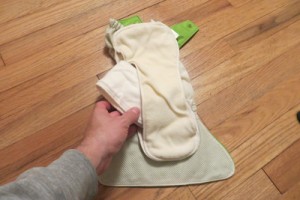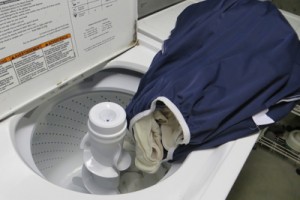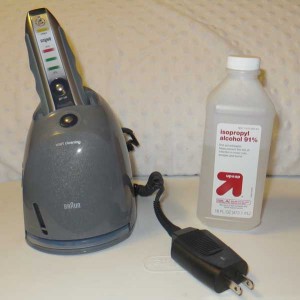We saved a bundle by switching to reusable cloth diapers. Here’s how we did it.
This post is going to talk a lot about feces. If you don’t have a baby already or in your future or if you just don’t want to read about how to restrain the mud bunnies, you might want to explore another corner of the internet for awhile.
That’s because there’s a lot of hell’s candy involved with babies. If you’re one of those people who gets squeamish at the site of chimp chunks you might want to just be sure your birth control situation is locked down because there is no escape from the butt brie once the baby arrives.
Now when you have a baby, one of the first decisions you’ll have to make is what kind of diapers you’re going to use. We knew we weren’t going to be purist about it so we accepted that some disposable diapers were in our future. At the same time, the image of how many diapers our baby would use before being potty trained was disturbing. A typical baby will go through some 3,800 diapers in its lifetime.
Our strategy was to minimize the use of disposables as much as was reasonable. We decided to go with a local diaper service company. At $100/month, the price was comparable to what we’d likely be paying in diapers given how many he was going through in the early stages. More importantly, the convenience and waste reduction made it worth it to us.
The service would deliver a nice, fresh packet of diapers to our doorstep each week and take away the bag of diapers soaked with pee and pocket pesto. Pretired Baby really seemed to like the diapers and they were very easy for tired new parents to deal with as well.
But once he started sleeping blissfully through the night at three months in, our minds cleared and we began to re-evaluate our diaper strategy. Eventually we settled on washable cloth diapers. We canceled the diaper service and purchased used GroVia diapers from DiaperSwappers.com.
These diapers, along with similar versions, consist of a cloth insert that snaps to a waterproof cover (or “wrap”). We bought about a dozen wraps (you can use them a few times before they need to be washed) and more than 30 diaper inserts. In retrospect, we could easily have gotten by with a few less of each. The trick to how many you need is to estimate how many diapers you need in a day, decide how long you want (or can stand) to go between washing and do the math. (You can always buy what you think you need and buy a few more later if you find you’re running too low before you do laundry.) We bought all our diapers and wraps used and paid about $400 for everything. That seems like a lot (even considering we broke even in four months), but keep in mind we’ll also be able to sell these again when we’re done, hopefully at a minimal loss.
We’ve been using these diapers for about a year now and really have no problems to report. Right now we’re still using one disposable at nighttime as our one attempt at an overnight cloth diaper resulted in soaked sheets.
How to use reusable cloth diapers
OK, so we’ve established that we no longer just pull off the diaper covered in butt butter and just drop it into the bin to be left out for the diaper service company. Now we were up to our elbows in squishy baby gravy — what are we supposed to do with it all? There are a number of subtleties to using these diapers you’ll need to know about if you’re planning to go this route. Nothing is terribly difficult once you get in the routine, but expect a little trial and error as you get started.
Now if you do any amount of research on these reusable cloth diapers, you’ll sooner or later come across someone touting the use of a “poop spatula.” The idea is that you keep an old spatula next to your toilet that is clearly marked “POOP”, or “MUD”, “DEUCE” or whatever you like. (The labeling is so you don’t accidentally end up mixing this spatula up with your cooking supplies.) We read about this concept and said, “Um, no.”
Fortunately there’s a better way to get the paydirt off your fancy new cloth diapers. It’s called a BioLiner and it acts as a handy barrier between the black banana and the diaper you’ll be tossing into your washing machine.
So proper assembly involves the outer wrap into which you’ll snap the cloth diaper, then you’ll add on a single BioLiner. Snap the kiddo up and you’re on your way.

For naps and other long stretches, you’ll need to add in a booster for extra pee storage to make sure the reusable cloth diaper can handle the volume.
But, wait, you say! Does that little strip of cloth really hold all that pee? Doesn’t it leak out? Well for normal, daily usage when you’re able to do a diaper change frequently, it can easily hold it. But for longer stretches, such as a nap, it’s not typically enough. The solution for that is something called a “booster.” It’s an additional strip of material that you add to the mix to hold the extra liquid. For boys you’ll want to fold it in half and place it right in the front.
How to wash the reusable cloth diapers
So say your crumb cruncher suddenly goes quiet and with a focused look begins grunting and straining. You know what lies in store. “Are you poopin‘?” you ask softly.
Sure enough, you pull back the diaper to reveal a fresh new set of moon rocks! Here’s what to do: Get your next diaper all prepped. Take off the offending diaper and carefully set it aside. Clean up the perpetrator and put him or her somewhere safe.
Next take the whole smelly mess to the bathroom and shake off the stink brick, kerplunk! right into the toilet. Now the BioLiner is supposedly “flushable” but that doesn’t mean it should be flushed. These “flushable” products are notorious for clogging up your home’s plumbing and are hated by utility companies who must contend with sewage systems that aren’t geared up for products that don’t break down in water. That said, there’s been two or three times when the chocolate surprise was so squished into the liner that it ended up going down the drain. You could alternatively bag it up and send it out with the trash, though. But generally I just hold the BioLiner by a clean corner and give the whole thing a little shake and the stinky pie drops into the water. Sometimes a little number 2 gets on the cover or the diaper where the BioLiner wasn’t covering well enough. That can be rinsed off or wiped off with some toilet paper.
So that gets rid of the nut log, but you still have the diaper to contend with. Unsnap it from the cover, pull out the booster if you had one in there, and drop the whole thing into your airtight diaper container. You’ll want to have two reusable diaper pail liners so that you can rotate them as you do your laundry.
Before you have kids, you imagine the nonstop supply of Wendy’s Frosties being the worst part of the diaper experience. It turns out it’s actually the eye-watering urine smell. It really builds up after a few days of urine-soaked cloth diapers sitting in a diaper pail. So I generally end up washing smaller loads twice a week instead of one big load once a week.
So here’s how to wash your cloth diapers. Hold your breath and quickly open the diaper pail and pull out the pail liner, closing it quickly. Once at your washing machine, hold your breath again and dump it in, making sure to spread them around. Then turn the liner inside-out and put it in there as well. We generally just wash the covers with the regular laundry but if some of them get a little butt hail on them, they can be washed with the diapers as well.
Don’t add any soap! First, you’ll run a rinse cycle on warm to get off any nuggets that have managed to escape the system so far. Once the rinse cycle completes, you’ll add the soap — and yes, you need special soap. We use Country Save Laundry Detergent and it seems to work great. Toss in a scoop, run the wash cycle on warm and add another rinse cycle at the end.
It doesn’t seem like that’d be enough to keep them clean, but they actually do come out perfectly clean on the other end. Unfortunately there’s one last step. Remove any covers and the liner bag, which can’t be put in the dryer. Hang those up to dry. Then turn each and every diaper inside-out so that it can dry completely. Run the dryer on medium heat and for as long as a cycle as your dryer has.
That’s it — put them away and they’re ready to catch another load of poo stew.
Just a couple other tips:
- Don’t use any Vaseline or waterproof diaper cream because those will ruin the absorbency of the diapers.
- Skip the dryer sheets. They leave a waxy (chemical) film on the material, reducing the absorbency. You’ll want to pick up a set of these dryer sheet alternatives instead.
- Over time they can start to smell a little woofy. Not like a sewer, but more like a wet dog. When that happens, or if they lose some absorbency, they need to be “stripped.” There are several ways to do it, which you can do your own research on, but we just washed ours a couple times in hot water and it seemed to do the trick.
- These diapers can get a little stained over time. When that happens, you can lay them out in the sun for a few hours (we have to wait until there’s some sun here in Seattle, which could be awhile). That should whiten them up enough to be tolerable.
OK, I think that’s everything I’ve learned about using reusable cloth diapers. What do the savings look like? Well, we were spending $100/month on the diaper service before and now we only buy one pack of disposables from Costco every few months. Obviously our utility costs have gone up a bit, although it’s been subtle enough I haven’t even noticed it, and it’s impossibly hard to measure. But I’d estimate we’ve easily saved at least $50/month and maybe as much as $75. That’s not too shabby. But the best part is all the disposables we’re not using. Having a baby is one of the worst things you can do for the environment, but hopefully we’ve eased that burden at least a little bit by using reusable cloth diapers.
Here’s your shopping list if you want to go this route. Remember to buy used whenever possible!
- Diaper pail such as Safety 1st Easy Saver Diaper Pail
. (We use a diaper genie for the wipes and occasional disposables and use a regular kitchen garbage can with a lid for the cloth diapers.)
- Diaper pail liners – You’ll want to get two so you can have a clean one ready while the other one dries out from its washing. For example: Planet Wise Diaper Pail Liner.
- GroVia BioLiners Diaper Liners
– A roll lasts about a month and you do not want to run out so get a couple rolls to start and then buy in bigger bulk once you’re sure you want to stick with it.
- Pick up a set of these dryer sheet alternatives to avoid waxy buildup on your nappies: PurEcoSheet Reusable Chemical-Free Dryer Sheets
.
- Reusable cloth diaper wraps. Here’s an example: GroVia Hybrid Snap Shell Diaper
- Reusable cloth diapers. There are a few different kinds, but for example: GroVia Certified Organic Cotton Soaker Pad
- Diaper Boosters
- Special laundry detergent – We like Country Save Laundry Detergent.






